[English] 日本語
 Yorodumi
Yorodumi- PDB-6klb: Structure of LbCas12a-crRNA complex bound to AcrVA4 (form B complex) -
+ Open data
Open data
- Basic information
Basic information
| Entry | Database: PDB / ID: 6klb | ||||||
|---|---|---|---|---|---|---|---|
| Title | Structure of LbCas12a-crRNA complex bound to AcrVA4 (form B complex) | ||||||
 Components Components |
| ||||||
 Keywords Keywords | RNA BINDING PROTEIN/RNA / CRISPR-Cas / anti-CRISPR / RNA BINDING PROTEIN / RNA BINDING PROTEIN-RNA complex | ||||||
| Function / homology | RNA / RNA (> 10) / Uncharacterized protein Function and homology information Function and homology information | ||||||
| Biological species |  Lachnospiraceae bacterium (bacteria) Lachnospiraceae bacterium (bacteria) Moraxella bovoculi (bacteria) Moraxella bovoculi (bacteria)synthetic construct (others) | ||||||
| Method | ELECTRON MICROSCOPY / single particle reconstruction / cryo EM / Resolution: 4.1 Å | ||||||
 Authors Authors | Peng, R. / Li, Z. / Xu, Y. / He, S. / Peng, Q. / Shi, Y. / Gao, G.F. | ||||||
 Citation Citation |  Journal: Proc Natl Acad Sci U S A / Year: 2019 Journal: Proc Natl Acad Sci U S A / Year: 2019Title: Structural insight into multistage inhibition of CRISPR-Cas12a by AcrVA4. Authors: Ruchao Peng / Zhiteng Li / Ying Xu / Shaoshuai He / Qi Peng / Lian-Ao Wu / Ying Wu / Jianxun Qi / Peiyi Wang / Yi Shi / George F Gao /  Abstract: Prokaryotes possess CRISPR-Cas systems to exclude parasitic predators, such as phages and mobile genetic elements (MGEs). These predators, in turn, encode anti-CRISPR (Acr) proteins to evade the ...Prokaryotes possess CRISPR-Cas systems to exclude parasitic predators, such as phages and mobile genetic elements (MGEs). These predators, in turn, encode anti-CRISPR (Acr) proteins to evade the CRISPR-Cas immunity. Recently, AcrVA4, an Acr protein inhibiting the CRISPR-Cas12a system, was shown to diminish Cas12a (LbCas12a)-mediated genome editing in human cells, but the underlying mechanisms remain elusive. Here we report the cryo-EM structures of AcrVA4 bound to CRISPR RNA (crRNA)-loaded LbCas12a and found AcrVA4 could inhibit LbCas12a at several stages of the CRISPR-Cas working pathway, different from other characterized type I/II Acr inhibitors which target only 1 stage. First, it locks the conformation of the LbCas12a-crRNA complex to prevent target DNA-crRNA hybridization. Second, it interacts with the LbCas12a-crRNA-dsDNA complex to release the bound DNA before cleavage. Third, AcrVA4 binds the postcleavage LbCas12a complex to possibly block enzyme recycling. These findings highlight the multifunctionality of AcrVA4 and provide clues for developing regulatory genome-editing tools. | ||||||
| History |
|
- Structure visualization
Structure visualization
| Movie |
 Movie viewer Movie viewer |
|---|---|
| Structure viewer | Molecule:  Molmil Molmil Jmol/JSmol Jmol/JSmol |
- Downloads & links
Downloads & links
- Download
Download
| PDBx/mmCIF format |  6klb.cif.gz 6klb.cif.gz | 486.9 KB | Display |  PDBx/mmCIF format PDBx/mmCIF format |
|---|---|---|---|---|
| PDB format |  pdb6klb.ent.gz pdb6klb.ent.gz | 388.8 KB | Display |  PDB format PDB format |
| PDBx/mmJSON format |  6klb.json.gz 6klb.json.gz | Tree view |  PDBx/mmJSON format PDBx/mmJSON format | |
| Others |  Other downloads Other downloads |
-Validation report
| Summary document |  6klb_validation.pdf.gz 6klb_validation.pdf.gz | 795.6 KB | Display |  wwPDB validaton report wwPDB validaton report |
|---|---|---|---|---|
| Full document |  6klb_full_validation.pdf.gz 6klb_full_validation.pdf.gz | 826.5 KB | Display | |
| Data in XML |  6klb_validation.xml.gz 6klb_validation.xml.gz | 75.6 KB | Display | |
| Data in CIF |  6klb_validation.cif.gz 6klb_validation.cif.gz | 115.5 KB | Display | |
| Arichive directory |  https://data.pdbj.org/pub/pdb/validation_reports/kl/6klb https://data.pdbj.org/pub/pdb/validation_reports/kl/6klb ftp://data.pdbj.org/pub/pdb/validation_reports/kl/6klb ftp://data.pdbj.org/pub/pdb/validation_reports/kl/6klb | HTTPS FTP |
-Related structure data
| Related structure data |  0705MC  0704C  6kl9C M: map data used to model this data C: citing same article ( |
|---|---|
| Similar structure data |
- Links
Links
- Assembly
Assembly
| Deposited unit | 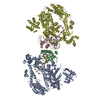
|
|---|---|
| 1 |
|
- Components
Components
| #1: Protein | Mass: 143888.359 Da / Num. of mol.: 2 Source method: isolated from a genetically manipulated source Source: (gene. exp.)  Lachnospiraceae bacterium (bacteria) / Production host: Lachnospiraceae bacterium (bacteria) / Production host:  #2: Protein | Mass: 27369.162 Da / Num. of mol.: 2 Source method: isolated from a genetically manipulated source Source: (gene. exp.)  Moraxella bovoculi (bacteria) / Gene: AAX07_09545 / Production host: Moraxella bovoculi (bacteria) / Gene: AAX07_09545 / Production host:  #3: RNA chain | Mass: 13482.020 Da / Num. of mol.: 2 / Source method: obtained synthetically / Source: (synth.) synthetic construct (others) #4: Chemical | ChemComp-MG / #5: Water | ChemComp-HOH / | Has ligand of interest | N | Has protein modification | Y | |
|---|
-Experimental details
-Experiment
| Experiment | Method: ELECTRON MICROSCOPY |
|---|---|
| EM experiment | Aggregation state: PARTICLE / 3D reconstruction method: single particle reconstruction |
- Sample preparation
Sample preparation
| Component | Name: LbCas12a-crRNA complex bound to AcrVA4 (form B complex) Type: COMPLEX / Entity ID: #1-#3 / Source: RECOMBINANT |
|---|---|
| Molecular weight | Value: 0.30 MDa / Experimental value: YES |
| Source (natural) | Organism:  Lachnospiraceae bacterium (bacteria) Lachnospiraceae bacterium (bacteria) |
| Source (recombinant) | Organism:  |
| Buffer solution | pH: 7.5 |
| Specimen | Conc.: 1 mg/ml / Embedding applied: NO / Shadowing applied: NO / Staining applied: NO / Vitrification applied: YES |
| Specimen support | Grid material: COPPER / Grid mesh size: 300 divisions/in. / Grid type: Homemade |
| Vitrification | Instrument: FEI VITROBOT MARK IV / Cryogen name: ETHANE / Humidity: 100 % / Chamber temperature: 277 K |
- Electron microscopy imaging
Electron microscopy imaging
| Experimental equipment |  Model: Titan Krios / Image courtesy: FEI Company |
|---|---|
| Microscopy | Model: FEI TITAN KRIOS |
| Electron gun | Electron source:  FIELD EMISSION GUN / Accelerating voltage: 300 kV / Illumination mode: FLOOD BEAM FIELD EMISSION GUN / Accelerating voltage: 300 kV / Illumination mode: FLOOD BEAM |
| Electron lens | Mode: BRIGHT FIELD / Alignment procedure: COMA FREE |
| Specimen holder | Cryogen: NITROGEN / Specimen holder model: FEI TITAN KRIOS AUTOGRID HOLDER |
| Image recording | Electron dose: 60 e/Å2 / Detector mode: SUPER-RESOLUTION / Film or detector model: GATAN K2 SUMMIT (4k x 4k) |
| EM imaging optics | Energyfilter name: GIF Bioquantum / Energyfilter slit width: 20 eV |
- Processing
Processing
| Software | Name: PHENIX / Version: 1.11.1_2575: / Classification: refinement | ||||||||||||||||||||||||||||||||||||||||||||
|---|---|---|---|---|---|---|---|---|---|---|---|---|---|---|---|---|---|---|---|---|---|---|---|---|---|---|---|---|---|---|---|---|---|---|---|---|---|---|---|---|---|---|---|---|---|
| EM software |
| ||||||||||||||||||||||||||||||||||||||||||||
| CTF correction | Type: PHASE FLIPPING AND AMPLITUDE CORRECTION | ||||||||||||||||||||||||||||||||||||||||||||
| Particle selection | Num. of particles selected: 508000 | ||||||||||||||||||||||||||||||||||||||||||||
| Symmetry | Point symmetry: C1 (asymmetric) | ||||||||||||||||||||||||||||||||||||||||||||
| 3D reconstruction | Resolution: 4.1 Å / Resolution method: FSC 0.143 CUT-OFF / Num. of particles: 60000 / Algorithm: FOURIER SPACE / Symmetry type: POINT | ||||||||||||||||||||||||||||||||||||||||||||
| Atomic model building | Protocol: FLEXIBLE FIT / Space: REAL / Target criteria: Correlation coefficient | ||||||||||||||||||||||||||||||||||||||||||||
| Atomic model building | PDB-ID: 6KL9 Accession code: 6KL9 / Source name: PDB / Type: experimental model | ||||||||||||||||||||||||||||||||||||||||||||
| Refine LS restraints |
|
 Movie
Movie Controller
Controller



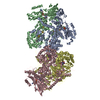
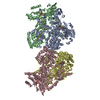
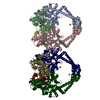
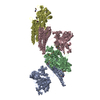

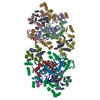
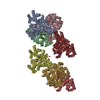
 PDBj
PDBj
































